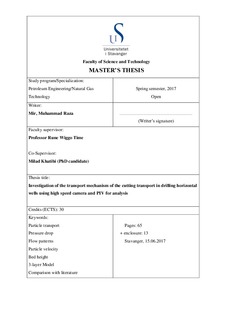| dc.contributor.advisor | Time, Rune Wiggo | |
| dc.contributor.author | Mir, Muhammad Raza | |
| dc.date.accessioned | 2017-10-26T14:10:04Z | |
| dc.date.available | 2017-10-26T14:10:04Z | |
| dc.date.issued | 2017-06-15 | |
| dc.identifier.uri | http://hdl.handle.net/11250/2462451 | |
| dc.description | Master's thesis in Petroleum engineering | nb_NO |
| dc.description.abstract | Dynamical feature of particle dunes is investigated in a horizontal drilling well. Apparently, it is quite challenging to transport the cuttings in horizontal section of the well because the cuttings tend to settle down and form a stationary bed. However, in this experimental study, the spherical particles were used to represent the cuttings in pipe flow. Different experiments were conducted in multiphase lab to have a better understanding of the fluid rheology; flow rate and pressure drop in horizontal section of the medium scale flow loop. Single phase and liquid-particle flow experiments were performed to compare different aspects. Various superficial liquid velocities applied to generate different length and height of particle dunes. In liquid-particle flow experiments, the spherical glass beads forming dune shape after 10 seconds flowing along with water in horizontal test section. The pressure drop over a length of 1.52 was measured. In addition, the images of particle dune were captured by high-speed camera during experimentations. Furthermore, the processing of the images is done by using MATLAB. The velocities of dune front and tail were computed using “MATLAB image view” to see how fast particles were moving with liquid flow. Although, the height of the bed was determined to investigate the increase or decrease in height of the dune bed while increasing superficial liquid velocities. The comparison of our study has been made with literature to see the similarities and differences so far. Furthermore, the experimental results were compared with 3-layer dynamic model as well to see if the simulations and experimental results show an agreement or observing a different phenomenon. To compare experimental and 3-layer dynamic model simulations, we used superficial liquid velocity (0.45 m/s). The 3-layer model work was done by Milad Khatibi (PhD candidate (University of Stavanger) and Johnny Petersen (IRIS Stavanger). | nb_NO |
| dc.language.iso | eng | nb_NO |
| dc.publisher | University of Stavanger, Norway | nb_NO |
| dc.relation.ispartofseries | Masteroppgave/UIS-TN-IPT/2017; | |
| dc.rights | Navngivelse 4.0 Internasjonal | * |
| dc.rights.uri | http://creativecommons.org/licenses/by/4.0/deed.no | * |
| dc.subject | petroleumsteknologi | nb_NO |
| dc.subject | petroleum engineering | nb_NO |
| dc.subject | 3-Layer model | nb_NO |
| dc.subject | particle transport | nb_NO |
| dc.subject | pressure drop | nb_NO |
| dc.subject | flow patterns | nb_NO |
| dc.subject | particle velocity | nb_NO |
| dc.subject | bed height | nb_NO |
| dc.subject | natural gas technology | nb_NO |
| dc.subject | naturgass | nb_NO |
| dc.title | Investigation of the transport mechanism of the cutting transport in drilling horizontal wells using high speed camera and PIV for analysis | nb_NO |
| dc.type | Master thesis | nb_NO |
| dc.subject.nsi | VDP::Technology: 500::Rock and petroleum disciplines: 510::Petroleum engineering: 512 | nb_NO |

